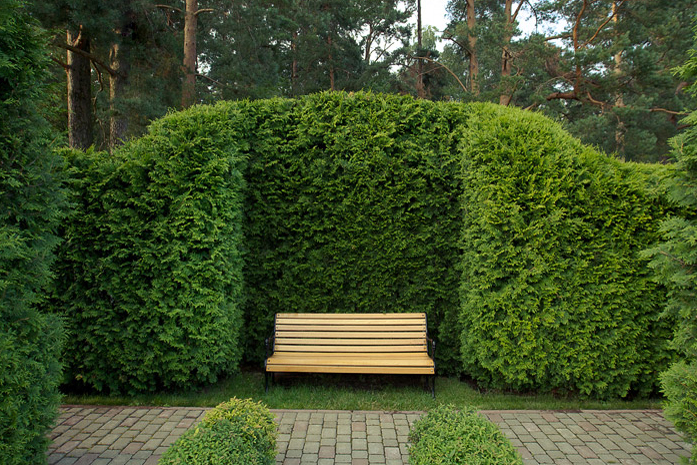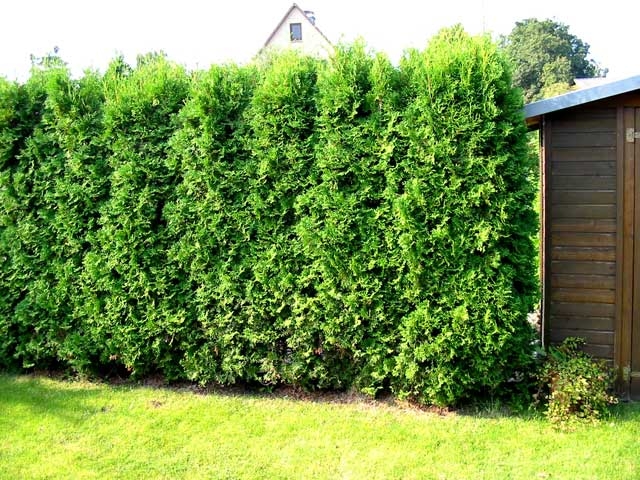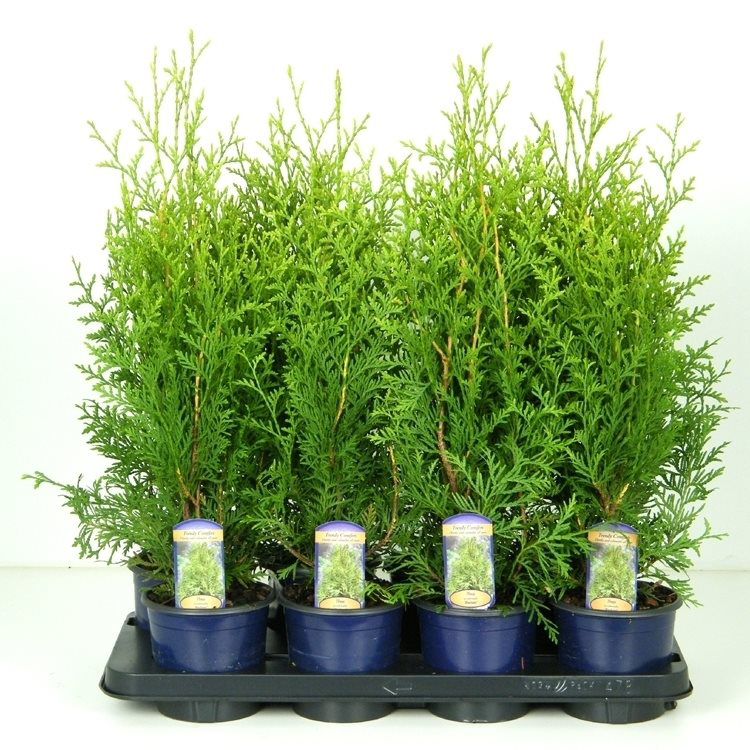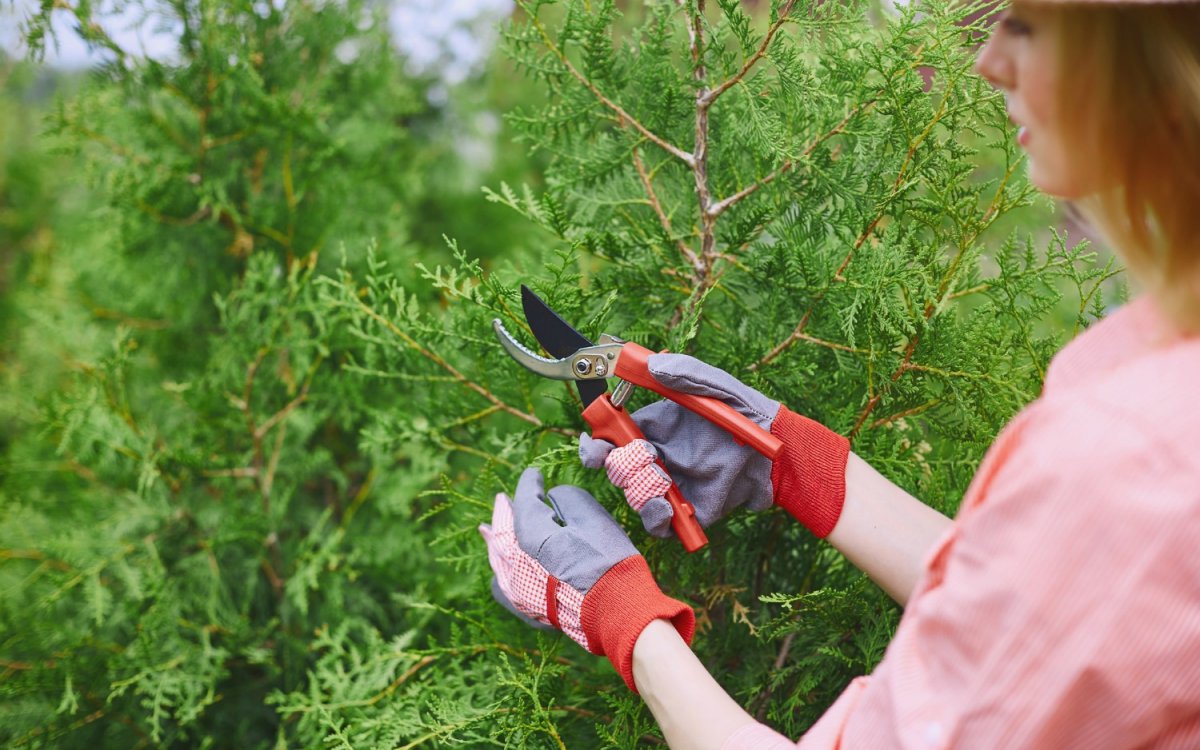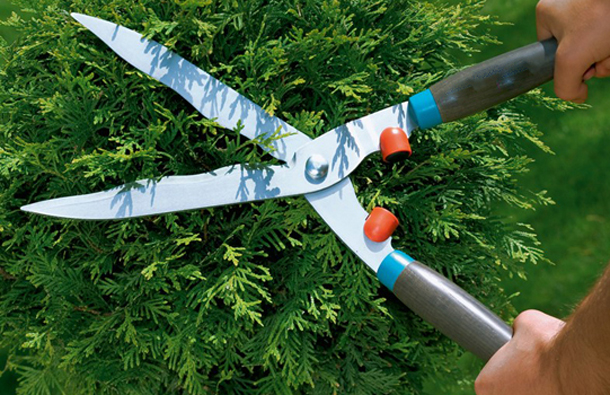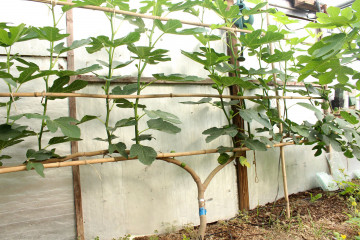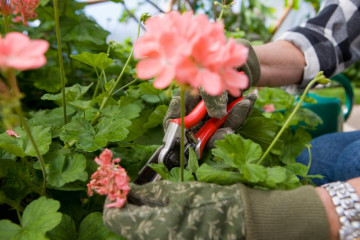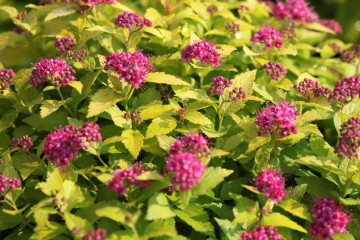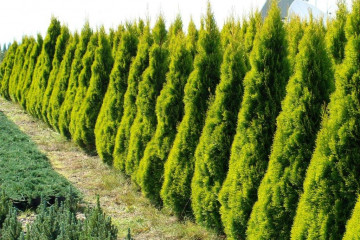Thuja hedges - pruning and shaping
Content:
In landscape design, hedges are an important architectural element. For its construction, many different shrubs are used. One of the most decorative and unassuming to care for is a thuja fence. This shrub is distinguished not only by decorativeness, but also by the ability to form a dense wall, it will protect the site from prying eyes, wind and noise. An unpretentious thuja, a hedge from which it grows over several years, does not require much attention. And its ability to release phytoncides will also have a beneficial effect on the health of the owners of such a green building.
There are a huge number of thuja varieties, but some of them are especially popular precisely as shrubs for creating living fences. Thuja varieties for hedges - which ones are better to choose? The most popular thuja for creating a green wall are Smaragd and Brabant.
Thuya Smaragd
This plant from the Cypress family has a pyramidal shape and a dense coniferous covering. Unlike some other species, it does not change the color of the needles in winter and always remains green. The life span of this species is on average 100-130 years, and during this time the shrub is capable of reaching sizes up to 6 m in height and up to 2 m in width.
This type has gained popularity due to its unpretentiousness and frost resistance. Thuja Smaragd perfectly tolerates even severe winter frosts, while maintaining the green color of the needles. Even the poorest soil and polluted city air is not afraid of it. This type is shade-tolerant, unlike others, but it does not tolerate high soil moisture and requires good drainage. The advantages include the fact that this shrub tolerates a haircut well, the constant formation of thuja Smaragd allows it to be used as an interesting decorative element in landscape design.
In the first spring months, the flowering period of the shrub occurs, small brown cones appear. It is at this time that the release of phytoncides by the plant increases, which helps to cleanse the air at the site and saturate it with useful substances.
The only disadvantage of thuja Smaragd is its slow growth. In a year, it adds only 15-20 cm in height and 5 cm in width. This fact makes it possible to cut the shrub less often, but it will take quite a long time for the hedge to turn from it into a dense wall.
Thuja Brabant
This type of thuja compares favorably with others by its rapid growth: in a year, the increase in growth is up to 40 cm up and up to 15 cm in width. True, this fact affects the frequency of haircuts, it must be done at least twice a year. The shrub has a lifespan of about 150 years, during which time it is able to reach a height of up to 15 m.
Brabant is quite unpretentious to the quality of the soil and tolerates short-term waterlogging and drought very well. Additional soil drainage during planting is not required. Also, this species feels good in the sun, but in the spring it is better to shade the plants due to the high probability of sunburn.It is frost-resistant, but it does not tolerate severe frosts, in contrast to the same emerald.
Brabant has a conical crown, needles of a light green hue. During the flowering period, it is covered with brown cones, which gives the bush a special decorative effect at this time.
It is easy to cut, and due to its rapid growth, the shape of the bush can be periodically modified. For those who want to quickly enjoy the dense green fence, Thuja Brabant is a great option.
Green wall care
Despite the fact that thuja is quite unpretentious, it still requires care. Particular attention should be paid to young plants, there are nuances here.
After planting, young seedlings require watering at least once a week, and twice in extreme heat. One shrub requires about 10 liters of water; during a drought, the irrigation rate should be doubled. After watering, loosening is mandatory, but not deep. The root system of thuja is very superficial, and there is a great danger of damaging fragile roots. The soil must be cultivated to a depth of no more than 10 cm.
Young thuja seedlings are not as hardy as older plants. During the first two years of growth, seedlings should be protected from winter frosts and bright spring sun. For this, you can use white non-woven material, kraft paper or spruce branches.
It is better to fertilize the soil before planting, in this case, during the first year, the seedlings will not need additional feeding. In addition, thuja does not tolerate an excess of mineral fertilizers. Only from the second year should one resort to mineral or organic fertilizing.
How to make a fence from a thuja
The realization of the dream of a green thuja fence begins with the acquisition of seedlings. In this matter, it is better to give preference to special nurseries or garden centers. In this case, the risk of acquiring a diseased plant or making a mistake with the view will be minimal. It is better to choose seedlings in containers that are no more than four years old, they take root better, and the root system will be protected during transportation. In addition, young plants will cost less than larger specimens.
It is better to plant plants to form a future green hedge in a trench way. This process can be divided into several stages:
- Digging a trench. The ditch for planting seedlings should have a depth of about 50 cm. The width should be such that the root system is located freely in it.
- Preparation of drainage and fertilizers. If the selected variety requires drainage, then a drainage layer is poured onto the bottom of the pit. The next layer should be compost. Instead, you can add peat, sand or mineral fertilizers. First of all, in this matter, the peculiarities of the soil on the site should be taken into account.
- Plants placement. The distance between the plants in the trench depends on the selected type of thuja and the speed of its growth. When planting the Brabant species, the gap between the seedlings should be at least a meter, 70 cm will be quite enough for the emerald.If the task is to create a dense green fence of two rows of shrubs, the plants are placed in a checkerboard pattern.
- Filling the trench with soil. First, the soil to fill the ditch must be cleared of roots, weeds and stones. If there is a chance of drought, it is better to add a hydrogel to the soil, it will help to retain moisture longer. The trench should be filled so that the root collar of the seedlings is not buried and remains level with the soil.
- Abundant watering. Young plants need a lot of moisture, especially at the beginning of growth.After planting, at least 10 liters of water is required for each seedling.
- Mulching. To preserve moisture, which is so necessary for young seedlings at first, plantings should be necessarily mulched. For this purpose, you can use peat, wood chips, sawdust or even just mown grass.
As an alternative to the trench planting method, you can plant the plants in separate holes. Planting technology and its stages are the same as in the trench method.
How to feed thuja for growth
Thuja is a very unpretentious plant, but still needs feeding. The amount of nutrients that the seedling received during planting should be enough for the first year of growth. From the second or third year, you should start applying mineral fertilizers or organic fertilizing.
It is better to choose mineral fertilizers in a specialized store, there are many options for thuja. They are usually applied superficially using the sprinkling method. The composition of such a fertilizer must necessarily include potassium, phosphorus and iron.
Thuja is also very responsive to organic feeding. Most often, compost or specialized manure is used for this purpose.
It is worth paying attention to the timing of fertilization. The first dose of fertilizer should be applied in the spring, half the annual rate. The second feeding is carried out in June.
The annual fertilizer rate per 10 m² is 1 kg. Top dressing should be moderate, thuja reacts negatively to an excess of mineral fertilizers in the soil.
With proper care, an evergreen thuja fence will turn out, which will delight its owners for many years.
How and when to trim thuja
To give the thuja crown the desired shape and maintain the health of the shrub, it is necessary to regularly prune. How to cut the thuja correctly and not harm the plant?
This procedure is carried out not only for aesthetic, but also for medicinal purposes. It can be divided into two types:
- Sanitary pruning. It is held in spring and autumn. The purpose of this procedure is to remove damaged branches and thin out the crown for better air permeability. It is also worth removing branches affected by diseases or parasites.
- Formative pruning. It is carried out in the period from late spring to early autumn, mid-summer is considered the best time. The result of such pruning should be a properly formed shrub crown that will meet the aesthetic requirements of its owner.
How to trim thuja depends on the growth rate of the plant, its aesthetic function and the health of the plant. For example, pruning thuja Smaragd may include only a sanitary function due to the naturally successful crown shape.
When carrying out this procedure, there is a risk of making some mistakes that can subsequently harm the plant.
- pruning in early spring. It is during this period that the time of intensive vegetation falls, and damage to the plant in this phase can stop this process;
- too much pruning. No more than 30% of the vegetative mass should be cut, otherwise the plant may not recover after such manipulations;
- slices close to the kidney. When pruning thuja, there are strict rules that you should adhere to. Branches growing upward are cut above the outer bud, and those directed downward are cut off above the inner one;
- exposing branches. This should also be avoided.Branches that are too exposed as a result of pruning will eventually dry out.
It is better to choose a cloudy day for pruning. After the procedure, the plant should be watered abundantly; fertilizing with mineral or organic fertilizers will not interfere.
For a plant like thuja, pruning and shaping are integral parts of grooming. You should be careful about when to cut thuja and how to do it correctly.
How to cut thuja: tools
It is not enough to know how to trim thuja, it is also worth paying attention to choosing the right tool.
The pruning tool should be selected depending on the thickness of the branches of the plant. This can be a pruner, garden shears, or brush cutter. Pruning shears and pruning shears are usually sufficient to trim the thuja.
The main point when preparing a tool for trimming is its sharpening. It should be sharp to avoid kinking on the branches. It is also recommended to wipe the blade of the tool with resin and cut branches during the cutting process to remove dirt from it.
How to trim a globular thuja
In landscape design, thuja is used not only for the construction of green walls, it also performs many different decorative functions. Spherical thuja look especially impressive in single plantings.
They fit perfectly into the landscape of the alpine hills, and into the landscape of flower beds, made in the English style. No less interesting is the combination of such a thuja with other ornamental shrubs, for example, with a vesicle.
This type of thuja by nature has a spherical bush shape, therefore, requires minimal pruning. Like other types of thuja, it requires sanitary and shaping pruning. Sanitation is carried out in the same way as for other species. Formative pruning for a spherical thuja is more gentle, it is only necessary to remove branches that protrude beyond the rounded shape.
Everyone can grow a living thuja fence, you just have to make a little effort. You need to be patient and have the right information. First of all, it is worth learning how to plant, how to fertilize shrubs and how to prune thuja. With a little effort, the green wall dream will come true.
